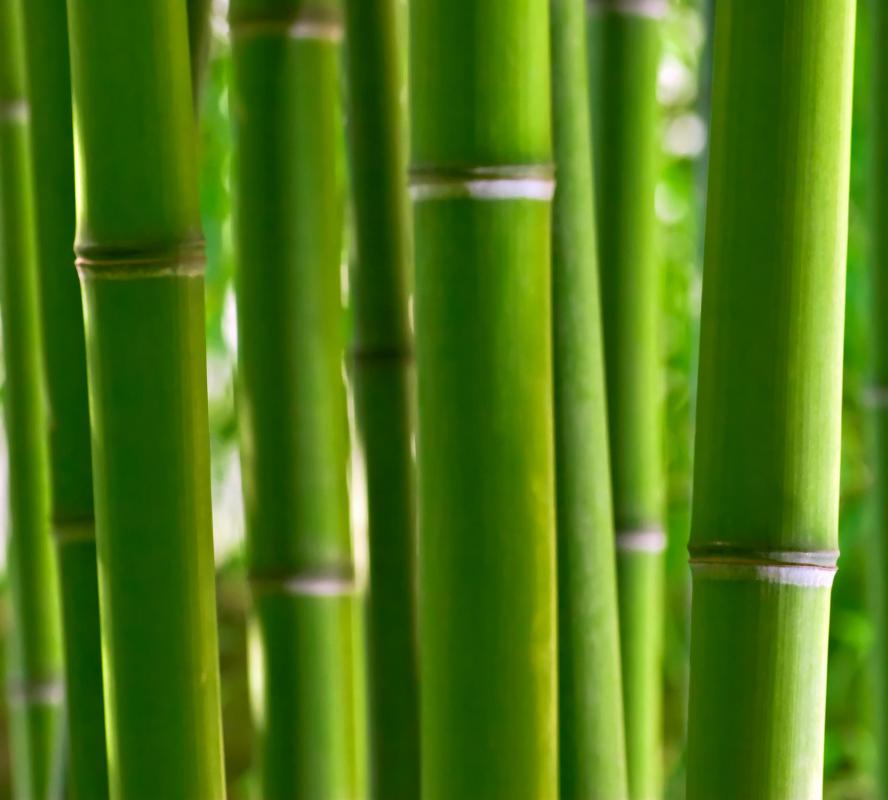At HomeQuestionsAnswered, we're committed to delivering accurate, trustworthy information. Our expert-authored content is rigorously fact-checked and sourced from credible authorities. Discover how we uphold the highest standards in providing you with reliable knowledge.
What are the Different Types of Bamboo Plants?
There are more than 1,450 species of bamboo plants. Of these, there are two basic types: those that spread and those that clump. Spreading bamboo, also called running bamboo, will cover any distance up to 100 feet (30.5 m) within a relatively short time period. Clumping bamboo, however, will stay in a tightly nit bunch and add only a few stalks around the edge every few months, typically growing 1-3 inches (2.54-7.62 cm) in circumference per year.
A few species of clumping bamboo are Chinese Mountain, Umbrella, Timor Black, Fountain, White Dragon and Borinda. A few species of running bamboo are Golden Grove, Kuma, Pygmy, Yellow Grove, Pitt White and Golden Square. Other than these two groups, bamboo plants are difficult to classify, because they can live almost anywhere and take many forms with many sizes, colors and niches in the environment. Growth patterns are the only black-and-white characteristics of bamboo. The rest of the plant's many forms seem to vary on continuums rather than categories.

The main difference between running and clumping bamboo has to do with their respective rhizomes. Rhizomes are stems that stick into the ground and shoot roots downward out of the nodes found in the classic structure of the bamboo plant. These nodes are also the source of reproduction because they also shoot new stalks up to the surface to form the stem of a new bamboo plant. Running bamboo must have longer rhizomes that shoot new stems quickly and often, whereas clumping bamboo has shorter, slower and generally less active rhizomes.

One can still plant running bamboo in one's yard without the risk of the bamboo taking over the yard — and the neighbor's yard — by using a rhizome barrier. This usually consists of a lining of plastic that is buried 30 inches (76.2 cm) deep that completely surrounds the bamboo field. This will keep the rhizomes from growing underground past the area in which one wants bamboo plants.
Another, less-defined way to categorize bamboo plants into types is by the temperature in which each plant thrives: hot or cold. A few species that grow best in hot weather are Alphonse Karr, Golden Goddess, Fernleaf and Midori Green. A few species that grow best in cold weather are Eisenach, Flavescens Inversa, Holochrysa and Koi. Interior bamboo plants are those that have short enough root systems to be grown in pots and can therefore be grown indoors. These include Ventricosa, Vittata, Koi and Tsuboi.
AS FEATURED ON:
AS FEATURED ON:












Discussion Comments
@indigomoth - One of the reasons bamboo is so popular for all those things is that it grows very fast, and in harsh conditions.
Which is good when you want it, and not so good when you don't. Bamboo is an incredible pest in a lot of areas, because it spreads really quickly and is very difficult to stop.
So, if you are thinking about buying or growing bamboo plants, you should definitely check up on how to keep them contained so that they don't take over your garden, and keep on spreading.
It's pretty amazing how much they can get out of bamboo plants. I don't know which ones are which, but I do know they are used for all kinds of things.
Bamboo shoots can be eaten, and of course the canes can be used as building supplies. Or just construction material in general, to make furniture and so forth.
And recently bamboo fabric has become really popular. It's much more earth friendly than cotton apparently, and has quite a nice stretchy feel to it.
Seems like a crop people could get behind!
Post your comments